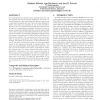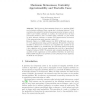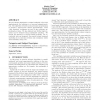1541 search results - page 200 / 309 » Analysis of Random Noise and Random Walk Algorithms |
STOC
2003
ACM
14 years 8 months ago
2003
ACM
The problem of cooperatively performing a set of t tasks in a decentralized setting where the computing medium is subject to failures is one of the fundamental problems in distrib...
CSDA
2008
13 years 8 months ago
2008
Tree models are valuable tools for predictive modeling and data mining. Traditional tree-growing methodologies such as CART are known to suffer from problems including greediness,...
WISEC
2010
ACM
14 years 1 months ago
2010
ACM
Key management in wireless sensor networks does not only face typical, but also several new challenges. The scale, resource limitations, and new threats such as node capture and c...
CORR
2010
Springer
13 years 6 months ago
2010
Springer
The Maximum Betweenness Centrality problem (MBC) can be defined as follows. Given a graph find a k-element node set C that maximizes the probability of detecting communication be...
STOC
2003
ACM
14 years 8 months ago
2003
ACM
We give efficient algorithms to sample uniformly, and count approximately, the solutions to a zero-one knapsack problem. The algorithm is based on using dynamic programming to pro...



